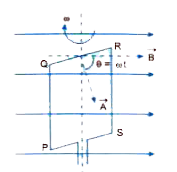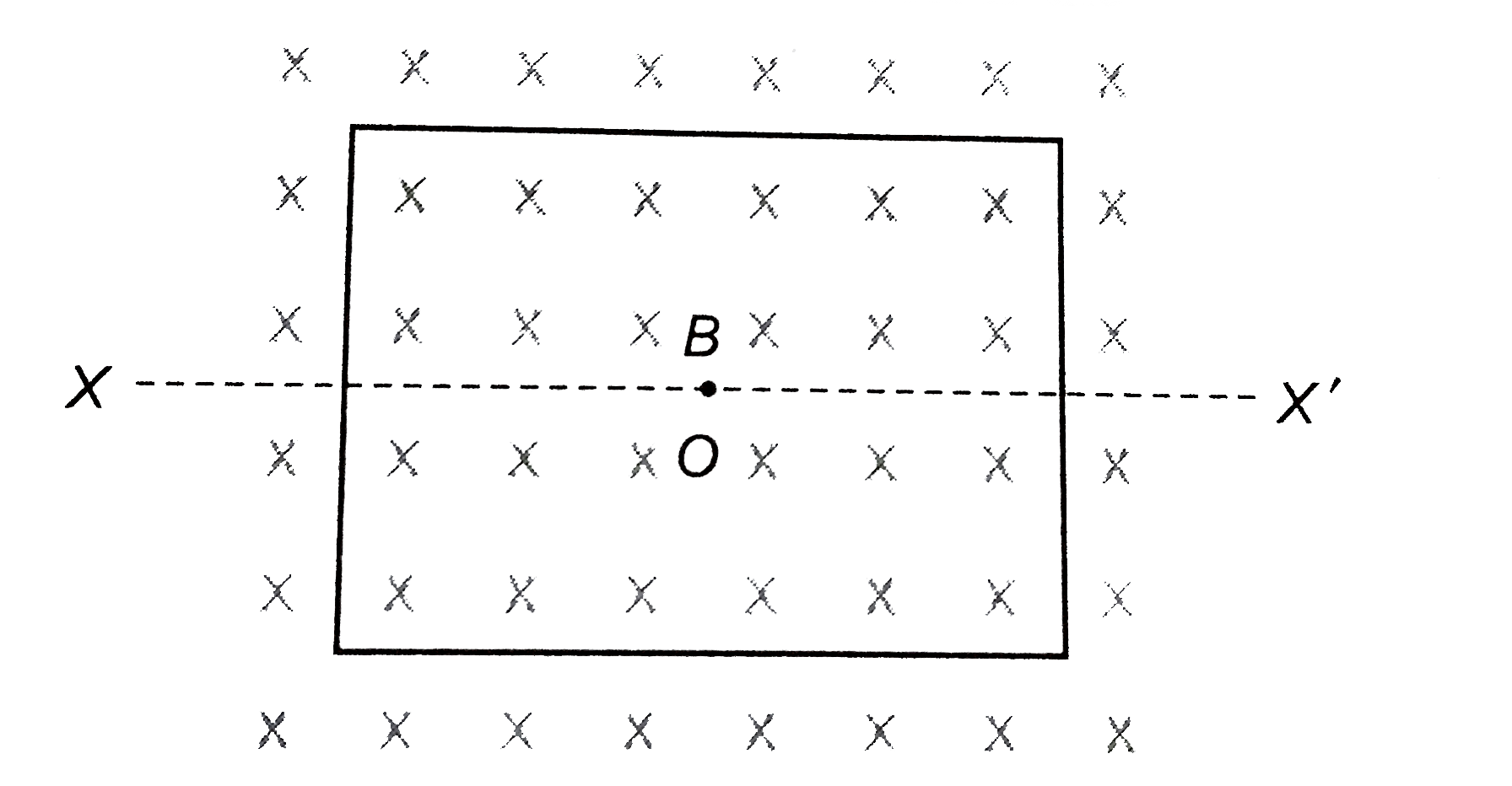A rectangular coil of area 'A', having number of turns N, is rotated at 'f' revolutions per second in a uniform magnetic field B, the field being perpendicular to the coil. Prove that the maximum emf induced in the coil is 2πfNBA.
Consider a rectangular coil PQRS of N turns, each of area A, held in a uniform magnetic field →B. Let the coil be rotated at a steady angular velocity w about its own axis.
Let at any instant t, normal to the area (i.e., the area vector →A) subtends an angle θ=ωt from direction of magnetic field →B. Then, at that moment, the magnetic flux linked with the coil is
ϕB=N→B.→A=NBAcosθ=NBAcosωt
∴ Induced emf ɛ=−(dϕB)dt=−ddt(NBAcosωt)
=−NBAddt(cosωt)=NBAωt
where ɛ0=NBAω = maximum value of induced emf.
If the coil be rotating at .f. revolutions per second, then ω=2πf and the maximum induced emf
ɛ0=NBAω=2πfNBA

Topper's Solved these Questions
- ELECTROMAGNETICE INDUCTIONBook:U-LIKE SERIESChapter:ELECTROMAGNETICE INDUCTIONExercise:Long Answer Questions -I
Explore 16 Videos
- ELECTROMAGNETICE INDUCTIONBook:U-LIKE SERIESChapter:ELECTROMAGNETICE INDUCTIONExercise:Long Answer Questions -II
Explore 9 Videos
- ELECTROMAGNETICE INDUCTIONBook:U-LIKE SERIESChapter:ELECTROMAGNETICE INDUCTIONExercise:Very Short Answer Questions
Explore 30 Videos
- ELECTROMAGNETIC WAVESBook:U-LIKE SERIESChapter:ELECTROMAGNETIC WAVESExercise:SELF ASSESSMENT TEST (SECTION C)
Explore 1 Video
- ELECTROSTATIC POTENTIAL AND CAPACITANCE Book:U-LIKE SERIESChapter:ELECTROSTATIC POTENTIAL AND CAPACITANCE Exercise:SELF ASSESSMENT TEST
Explore 1 Video
Similar Questions
(a) Explain the meaning of the term mutual inductance. Consider two concentric circular coils, one radius r1 and the other of radius r2(r1<r2) placed coaxially with centres coinciding with each other. Obtain the expression for the mutual inductance of the arrangement.
(b) A rectangular coil of area A, having number of turns N is rotated at 'f' revoluation per second in a uniform magnetic field B, the field being perpendicular to the coil. Prove that maximum emf induced in the coil is 2πfNBA.
View SolutionA rectangular coil of area A, having number of turns N is rotated at 'f' revoluation per second in a uniform magnetic field B, the field being perpendicular to the coil. Prove that maximum emf induced in the coil is 2πfNBA.
View Solution
Knowledge Check
A boy peddles a stationary bicycle the pedals of the bicycle are attached to a 200 turn coil of area 0.10m2. The coil rotates at half a revolution per second and it is placed in a uniform magnetic field of 0.02 T perpendicular to the axis of rotation of the coil. The maximum voltage generated in the coil is
A1.26VB2.16VC3.24VD4.12VA boy peddles a stationary bicycle the pedals of the bicycle are attached to a 200 turn coil of area 0.10m2. The coil rotates at half a revolution per second and it is placed in a uniform magnetic field of 0.02 T perpendicular to the axis of rotation of the coil. The maximum voltage generated in the coil is
A1.26VB2.16VC3.24VD4.12VA rectangular coil of area→Aand number of turns n is placed in a uniform magnetic field vecB. If the coil carries a current I, then the torque acting on the coil is given by
Ani(→A.→B)B1n(i→A×→B)C1n(i→A.→B)Dni(→A×→B)
A person peddles a stationary bicyle the pedals of the bicycle are attached to a 100 turn coil of area 0.10m2. The coil rotated at half a revolution per second and it is placed in a uniform magnetic field of 0.01T
perpendicular to the axis of rotation of the coil, What is the maximum voltage generated in the coil ?
View SolutionA rectangular coil is placed in a region having a uniform magnetic field B perpendicular to the plane of the coil. An emf will not be induced ion the coil if the

View SolutionA coil is rotated in a uniform magnetic field about an axis perpendicular to the field. The emf induced in the coil would be maximum when the plane of coil is :
View SolutionA 100 turn coil of area 0.1m2 rotates at half a revolution per second. It is placed in a magnetic field of 0.01 T perpendicular to the axis of rotation of the coil. Calculate the maximum voltage generated in the coil.
View SolutionA rectangular coil is placed in a region having a uniform magnetic field B perpendicular to the plane of the coil. An emf will not be induced ion the coil if the

View Solution
